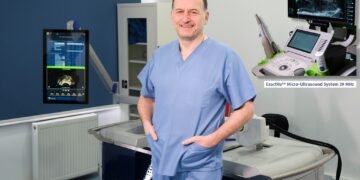As you may know, prostate cancer is a disease that often progresses without symptoms, which makes early detection essential. In addition to PSA blood testing, accurate and effective diagnosis of prostate cancer requires the use of modern diagnostic tools — one of the most advanced being micro-ultrasound imaging and, when necessary, targeted biopsy guided by micro-ultrasound.
What is micro-ultrasound?
It is a cutting-edge technology developed specifically for the evaluation of prostate cancer. The early detection of prostate cancer poses a major global challenge, which is precisely why micro-ultrasound devices were created.
What makes it different from standard ultrasound?
Unlike conventional ultrasound, which uses 5–10 MHz frequency, micro-ultrasound operates at a much higher frequency of 29 MHz, providing 300% sharper and more detailed imaging at the cellular level. This allows the detection of even the smallest suspicious lesions — as tiny as the width of a human hair.
The procedure is quick and has several advantages over MRI:
- Shorter examination time, with same-day results available for the patient
- No special preparation is required
- No contraindications for patients with obesity, claustrophobia, or implants
- More cost-effective
What is transrectal and transperineal prostate biopsy under micro-ultrasound guidance?
Targeted transrectal and transperineal prostate biopsy is a minimally invasive urological procedure. During the transrectal approach, a special probe is inserted into the rectum to visualize the prostate, detect suspicious areas, and guide the biopsy. This outpatient procedure takes about 10 minutes and requires only light anesthesia using lidocaine solution.
In the transperineal approach, where the needle is inserted through the perineum, the procedure is performed in an inpatient setting under light anesthesia. The patient is typically discharged the same day.
Advantages of the transperineal method include:
- Lower risk of infection
- Suitable for larger prostates
- Allows access to all regions of the prostate via the perineum
Prostate biopsy under micro-ultrasound guidance enables precise detection of suspicious areas and ensures nearly 100% targeted sampling of tissue. Its effectiveness has been validated by scientific studies.
But that’s not where its potential ends — it also enables Fusion Biopsy. This technique represents the highest advancement in prostate biopsy. If the patient has a pre-recorded MRI, it can be fused live during the procedure with micro-ultrasound imaging, allowing ultra-precise detection and sampling of suspicious lesions.








